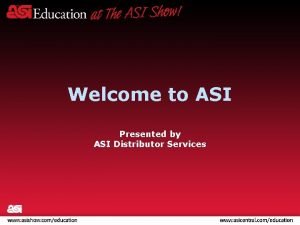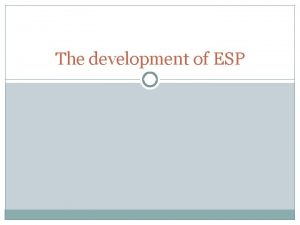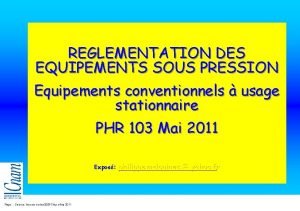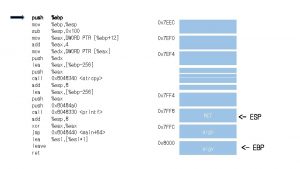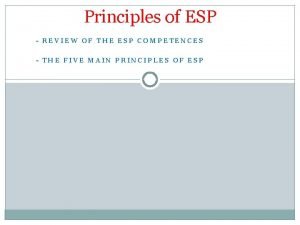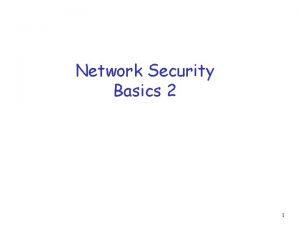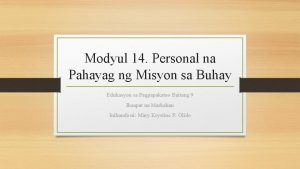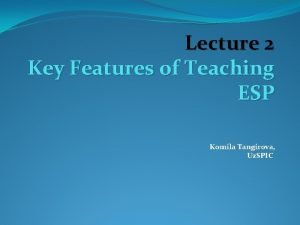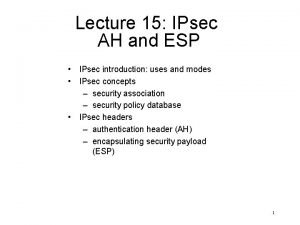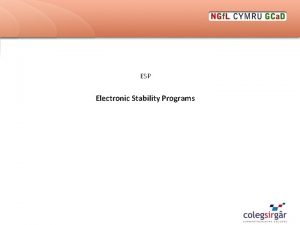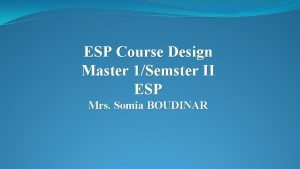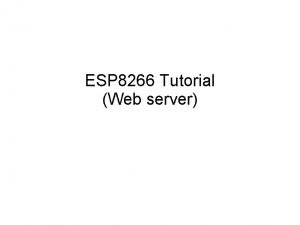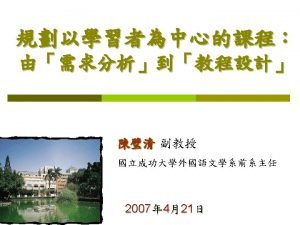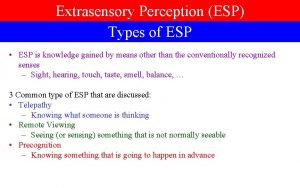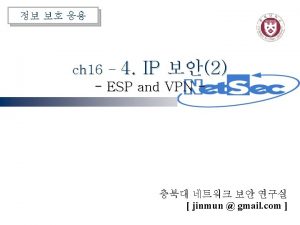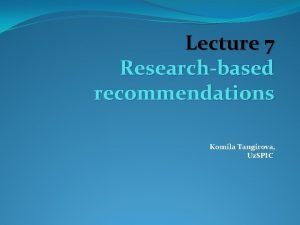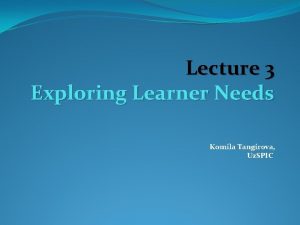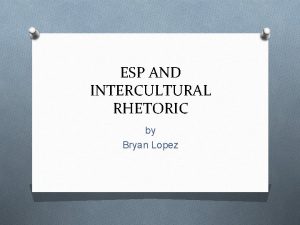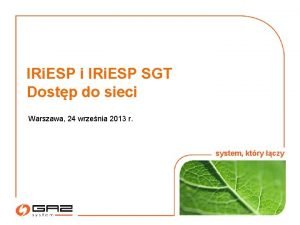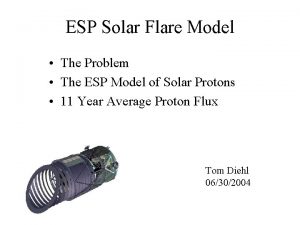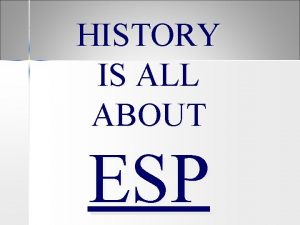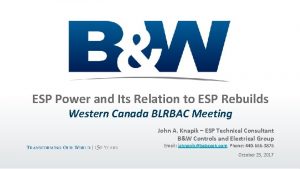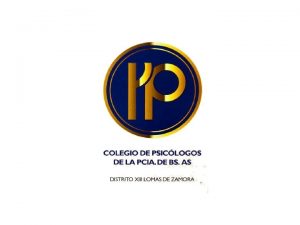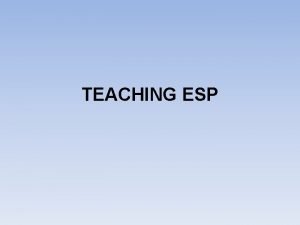Lecture 2 Key Features of Teaching ESP Komila




















- Slides: 20

Lecture 2 Key Features of Teaching ESP Komila Tangirova, Uz. SPIC

Outline: �What is ESP? �Branches and sub-branches of ESP �Aspects of teaching ESP �Issues in ESP �Absolute and Variable characteristics of ESP �The Four pillars �Complimentary and Competing approaches to ESP

What is ESP? English for Specific Purposes (ESP) is an approach to language teaching that targets the current and/or future academic or occupational needs of learners, focuses on the language, skills, discourses, and genres required to address these needs, and assists learners in meeting these needs through general and/or discipline-specific teaching and learning methodologies (Anthony, 2015: 2).

Branches of ESP is an umbrella term comprising EAP and EOP which in their turn have their subbranches. • English for Academic Purposes (EAP), which provides learners with the appropriate language skills for pursuing a tertiary-level course taught in English, and/or presenting, researching, and publishing in academic settings. • English for General Academic Purposes (EGAP) • English for Specific Academic Purposes (ESAP)

Branches of ESP English for Occupational Purposes (EOP), concerned with enabling a learner to function in English in a particular job or profession. �English for Professional Purposes (EPP) �English for Vocational Purposes (EVP)

Branches of ESP (Anthony, 2018: 14)

Branches of ESP But what is important to remember according to Anthony (2018: 15) is that All categories are abstractions; they are simplifications of reality that help us to explain and communicate complex ideas. In reality, there is no EAP or EOP. Instead, we have a continuum of needs that are weighed more strongly in one area or setting than another, or relate to one group more strongly than another. Similarly, we have language features that appear more prominent or frequently in one context that another, and genres and skills that more important for one person or group that another.

Aspects of teaching ESP has been receiving increasing interest with the focus on different aspects in the field including : • investigations into subject-specific content (e. g. Banegas, 2017) • teaching materials (e. g. García Laborda, 2011); • discursive and genre features of various academic and professional domains (e. g. Belcher, 2004; Li & Wharton, 2012; Wharton, 2012); • learner-centered approach in ESP pedagogy (e. g. Hutchinson & Waters, 1987; Sysoyev, 2000); • the application of needs analysis to courses, syllabi and materials development (e. g. Basturkmen 2013; Belcher, 2006; Chostelidou, 2010); • cooperation between ESP and content teachers (e. g. Atai & Fatahi. Majd, 2014; Barron, 1992; Northcott & Brown, 2006); • policies and issues at higher education in planning and delivering ESP courses (e. g. Evans & Morrison, 2011; Hoa, 2016; Murray, 2015; Murray & Hicks, 2016; Murray & Nallaya, 2016).

Issues in ESP A widespread issue in many contexts around the world is that �ESP teachers rely on their general teacher qualification in English as a Foreign Language �frequently lack expertise to provide instructions for language in specific domains while students expect more input with specialised nature. (e. g. Hüttner et al. , 2009; Jašková, 2016; Tangirova, 2017) �Link between teaching recources and students’ needs (Edwards, 2000; Medrea & Rus, 2012)

Addressing the issues: Lockwood (2012: 14) argues that research-based approach to ESP syllabus and teaching content design generates “improved outcomes”. In other words, it is important that teachers responsible for developing teaching content should be informed of what their learners need and then comply with the principles formed as a result of research. Murray (2010) suggests focusing on general proficiency, academic literacy and professional communication skills to meet students’ needs and bring their English proficiency to the appropriate level for future workplaces.

Aspects of ESP Supporters of ESP talk about how ESP differs from General English and how it motivates learners because it is focused on the content of their specialised discipline. On the other hand, the opponents claim that ESP is narrowly focused on adult learners in workplace settings, and that you can’t be an ESP instructor unless you are an expert in a specialised discipline.

Absolute and Variable characteristics of ESP by Strevens (1988) I. Absolute characteristics • ESP consists of language teaching which is designed to meet specified needs of the learner; • related in content (i. e. in tis themes and topics) to particular disciplines, occupations and activities; • centred on the language appropriate to those activities in syntax, lexis, discourse, semantics, etc. , and analysis of this discourse; • in contrast with general English II. Variable characteristics • ESP may be, but is not necessarily • restricted as to the language skills to be learned (e. g. reading only)

Absolute and variable characteristics of ESP by Dudley-Evans & St. John (1998) I. Absolute characteristics � ESP is defined to meet specific needs of learners; � ESP makes use of the underlying methodology and activities of the discipline it serves; � ESP is centred on the language appropriate to these activities in terms of grammar, lexis, register, study skills, discourse, and genre. II Variable characteristics � ESP may be related to or designed for specific disciplines � ESP may use, in specific teaching situations, a different methodology from that of general English � ESP is likely to be designed for adult learners, either at a tertiary-level institution or in a professional work situation. It could, however, be for learners at secondary school level; � ESP is generally designed for intermediate or advanced students; � Most ESP courses assume some basic knowledge of the language systems.

The four pillars One more important framework has been proposed by Anthony (2018). He distinguishes four pillers. They are: § Needs analysis § Learning objectives § Materials and Methods § Evaluation

Complimentary and Competing approaches to ESP Finally, we should touch upon the approaches to ESP teaching. In recent years, various approaches to teaching have appeared which is some cases are complementary and in other competing to ESP: For example, among such approaches are: § Task-based language Teaching (TBLT) and its variation Problem. Based Learning. Both are quite complimentary to ESP even though their functions overlap. Teachers can use these approaches at teaching ESP § Content-Based Instruction (CBI), sometimes referred to as Content. Based Learning (CBL) and English-Medium Instruction (EMI) are often seen as competing to ESP § Finally, there is also approach called CLIL -Content and Language Integrated Learning

References 1. Anthony, L. (2015). The changing role and importance of ESP in Asia. English as a Global Language Education (Ea. GLE) Journal, 1, 01 -21. 2. Atai, M. R. , & Fatahi-Majd, M. (2014). Exploring the practices and cognitions of Iranian ELT instructors and subject teachers in teaching EAP reading comprehension. English for Specific Purposes, 33, 27 -38. 3. Barron, C. (1992). Cultural synchronicity: Cooperative relationship between the ESP unit and other departments. Hong Kong Papers in Linguistics and Language Teaching, 15, 1 -14. 4. Banegas, D. L. (2018). Learning subject-specific content through ESP in a Geography teaching programme: An action research story in Argentina. English for Specific Purposes, 50, 1 -13. 5. Basturkmen, H. L. (2013). Needs analysis and syllabus design for LSP. In C. A. Chapelle (Ed. ). The encyclopedia of applied linguistics (pp. 4209 -4217). Chichester: Wiley Blackwell. 6. Belcher, D. D. (2004). Trends in teaching English for specific purposes. Annual Review of Applied Linguistics, 24, 165 -186. 7. Belcher, D. D. (2006). English for specific purposes: Teaching to perceived needs and imagined futures in worlds of work, study, and everyday life. TESOL Quarterly, 40(1), 133 -156. 8. Chostelidou, D. (2010). A needs analysis approach to ESP syllabus design in Greek tertiary education: A descriptive account of students’ needs. Procedia-Social and Behavioral Sciences, 2(2), 4507 -4512. 9. Dudley-Evans, T. , & St. John, M. J. (1998). Developments in English for specific purposes: A multidisciplinary approach. Cambridge: Cambridge University Press. 10. Edwards, N. (2000). Language for business: Effective needs assessment, syllabus design and materials preparation in a practical ESP case study. English for Specific Purposes, 19(3), 291 -296. 11. Evans, S. , & Morrison, B. (2011). Meeting the challenges of English-medium higher education: The first-year experience in Hong Kong. English for Specific Purposes, 30(3), 198 -208. 12. García Laborda, J. (2011). Revisiting materials for teaching languages for specific purposes. Online Submission, 17(1), 102 -112.

13. Hoa, N. (2016). Difficulties in Teaching English for Specific Purposes: Empirical Study at Vietnam Universities. Higher Education Studies, 6(2), 154 -161. 14. Hutchinson, T. , & Waters, A. (1987). English for Specific Purposes: A learning-centred approach. Cambridge: Cambridge University Press. 15. Hüttner, J. , Smit, U. , & Mehlmauer-Larcher, B. (2009). ESP teacher education at the interface of theory and practice: Introducing a model of mediated corpus-based genre analysis. System, 37(1), 99 -109. 16. Li, T. , & Wharton, S. (2012). Metadiscourse repertoire of L 1 Mandarin undergraduates writing in English: A cross-contextual, cross-disciplinary study. Journal of English for Academic Purposes, 11(4), 345 -356. 17. Medrea, N. , & Rus, D. (2012). Challenges in Teaching ESP: Teaching Resources and Students’ Needs. Procedia Economics and Finance, 3, 1165 -1169. 18. Murray, N. (2010). Considerations in the post-enrolment assessment of English language proficiency: Reflections from the Australian context. Language Assessment Quarterly, 7(4), 343 -358. 19. Murray, N. (2015). Standards of English in higher education: Issues, challenges and strategies. Cambridge: Cambridge University Press. 20. Murray, N. , & Hicks, M. (2016). An institutional approach to English language proficiency. Journal of Further and Higher Education, 40(2), 170 -187. 21. Murray, N. , & Nallaya, S. (2016). Embedding academic literacies in university programme curricula: a case study. Studies in Higher Education, 41(7), 1296 -1312. 22. Strevens, P. (1988). ESP after twenty years: A re-appraisal. ESP: State of the Art, 1 -13 23. Sysoyev, P. V. (2000). Developing an English for Specific Purposes course using a learner centered approach: A Russian experience. The Internet TESL Journal, 6(3), 18 -23. 24. Tangirova, K. (2017). Novice Teachers. In R. West & E. Sheyhametova. (Eds. ), State of English in Higher Education in Uzbekistan: A Baseline Study (pp. 58 -63). Tashkent: British Council, Uzbekistan World Languages University, Uzbekistan Scientific-Practical Innovation Centre, Ministry of Higher and Secondary Specialised Education. Unpublished study report.

Further reading 1. Basturkmen. H. (2010). Developing courses in English for specific purposes. Basingstoke: Palgrave Macmillan. 2. Harding, K. (2007). English for specific purposes. Oxford: Oxford University Press. 3. Laurence, A. (2018). Introducing English for specific Purposes. Oxon: Routledge. 4. Paltridge, B. (2009). Afterword: Where we have come from and where are we now? In D. Belcher (Ed. ). English for specific purposes in theory and practice (pp. 289 -296). Ann Arbor: University of Michigan Press. 5. Sheppard, C. , Manalo, E. , & Henning, M. (2018). Is ability grouping beneficial or detrimental to Japanese ESP students' English language proficiency development? English for Specific Purposes, 49, 39 -48. 6. Yang, M. N. (2015). A nursing academic word list. English for specific purposes, 37, 27 -38.

Useful resources 1. 2. 3. 4. 5. Asian ESP Journal English for Specific Purposes World (ESP World) ESP Today Journal of English for Academic Purposes

Home assignment Reflection task Based on what you have learnt from this lecture, write a one-page reflection describing the features of teaching ESP in your own context. Question/Answer 1. What is ESP? 2. What are the branches and sub-brunches of ESP? 3. What aspects of ESP have been researched? 4. What are some of the issues in the field of ESP? 5. What are the four pillars of ESP? A Practical Task Choose a particular branch of ESP and develop an activity or task based on the characteristics of ESP teaching.
 01:640:244 lecture notes - lecture 15: plat, idah, farad
01:640:244 lecture notes - lecture 15: plat, idah, farad Key partners business model
Key partners business model Key partners key activities key resources
Key partners key activities key resources Micro teach meaning
Micro teach meaning Asi top 40 distributors
Asi top 40 distributors The development of esp
The development of esp Exemple plan d'inspection esp
Exemple plan d'inspection esp Lea vs mov
Lea vs mov Principles of esp
Principles of esp Esp protocol 50
Esp protocol 50 Target needs analysis
Target needs analysis Lokal at global na demand
Lokal at global na demand Personal na pahayag ng misyon ng buhay
Personal na pahayag ng misyon ng buhay The four pillars of esp
The four pillars of esp Ah vs esp
Ah vs esp Esp logistics technology
Esp logistics technology Esp aim
Esp aim Course design in esp
Course design in esp Esplorer tutorial
Esplorer tutorial Real content and carrier content in esp
Real content and carrier content in esp Egp english
Egp english




